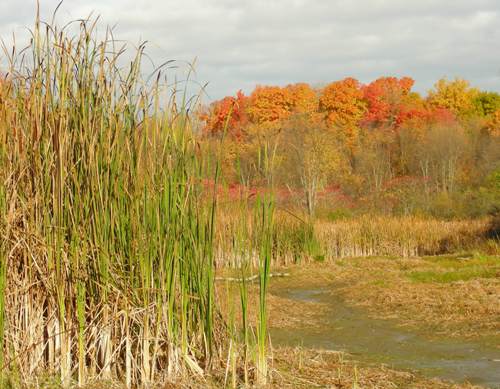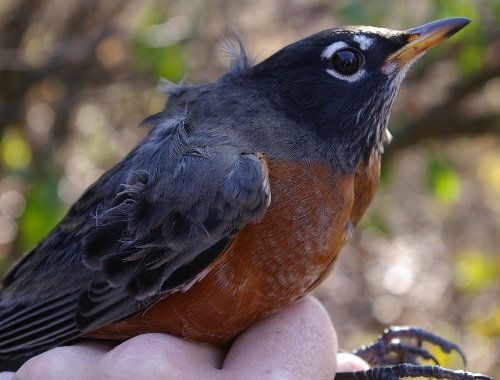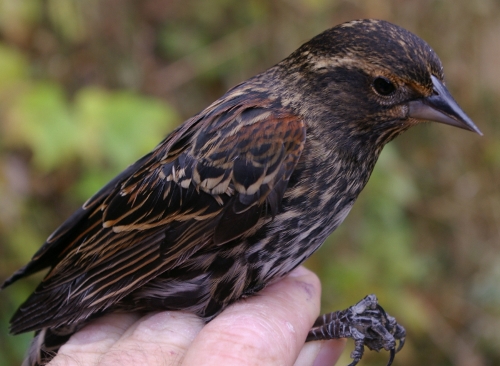|
Week 12: October 17-23, 2008 |
Welcome
to the McGill Bird Observatory weekly report.
Click here for a complete listing of our archives.
Comments or
questions are welcome at "mbo AT migrationresearch.org".
|
PICTURE
OF THE WEEK: |
|

With migration tapering off, we finally had a bit more time to appreciate the gorgeous fall
colours at MBO this fall. This photo was taken from the small lookout point along the
census trail on the west side of Stoneycroft Pond. In addition to showing the nice line
of sugar maples in the distance, it highlights the dramatic invasion of cattails into the
pond - some active habitat management is needed before next spring to ensure that
the pond does not get further choked out by vegetation, limiting its attractiveness to
birds that have nested in the past, such as Pied-billed Grebes and Canada Geese.
(Photo by Marcel Gahbauer)
|
|
|
THIS WEEK |
THIS FALL |
2008 TOTAL |
SITE TOTAL |
|
# birds (and species) banded |
218 (14) |
4877 (77) |
5719 (84) |
18697 (105) |
|
# birds (and species) repeat |
52 (12) |
891 (47) |
1089 (48) |
3315 (65) |
|
# birds (and species) return |
-- |
29 (14) |
121 (22) |
452 (32) |
|
# species observed |
57 |
140 |
158 |
197 |
|
# net hours |
402.2 |
5316.5 |
8228.7 |
30174.5 |
|
# birds banded / 100 net hours |
54.2 |
91.7 |
69.6 |
62.0 |
|
|
Note: table does not include nocturnal banding (owls) |
|
Banders-in-charge: Barbara Frei, Marcel Gahbauer, Marie-Anne Hudson, James Junda
Assistants: Sophie Cauchon, Shawn Craik, David Davey, Simon Duval, Luc Farly, Nicki Fleming, Maura Forrest, Tiffany Gamelin, Tiffany Gilchrist, Gay Gruner, Meggy Hervieux, Marie-Mellissa Kalamaras, Kristen Keyes, Gillian Kinsman, Emma Loosigian, Barbara MacDuff, Chris Murphy, Marie Nicole, André Pelletier, Emily Roy-Dufresne, Cat Spina, Rodger Titman, Carine Touma, Virginie Voudine
Notes: With early morning temperatures below freezing and even the first snowflakes (gasp!) seen in many months, the chilly part of late fall made its arrival known this week. Yet the crisp mornings were very pleasant, as inside the banding cabin we were warmed by the woodstove and outside we were entertained by large noisy flocks of American Robins, Common Grackles, and Red-winged Blackbirds against the backdrop of blazing red, orange, and yellows from the arboretum’s maple bush. As these large flocks sometimes alight in the group of cottonwoods beside the station we enjoyed their cacophony of sound and watching them feed and chase one another (the robins especially appear rather rambunctious at times!). At these times we are of two minds; hoping some of them will find their way into the nets, but certainly not all of them at once! The blackbirds often stay in the treetops, so unlike in spring we band very few of them - but we do catch the robins in good numbers each fall. Despite the lower total number of birds banded this week, our season total is now almost 50% greater than our previous fall record. The only question now is whether we will get to 5000 for the season - based on past years, it should be possible!
With just one more week left in the fall season after this, we were very happy to add 6 more species to the list of species observed this season! Flyovers included an arrow-straight Common Loon and a small flock of Greater Snow Geese. On Friday a pair of House Sparrows was spotted on the site (yes, they are that rare at MBO!) as well as a lone Eastern Bluebird. Two days later 3 bluebirds perched for a short while on our windmill, charming us with their sky-blue color against the matching sky. Saturday on the census walk, the nighthawk-like call note of an Eastern Meadowlark was heard a few times before the bird came into view - it's a good thing it wasn't singing, as we would have seriously doubted its proclamation of "spring of the ye-ear"! Lastly, the plowing of the adjacent fields lived up to expectations, offering a welcome stopover site for a flock of Horned Larks.

Now we just have to say it, this is one sexy bird! This after-hatch-year American Robin is a picture-perfect example of his kind, with a dark head, bright white broken eye ring, and characteristically brick-red breast.
(Photo by James Junda)
|
American Robins finally pushed their way to the top of the list of birds banded this week, becoming the first non-warbler this fall to hold that position. The Yellow-rumped Warblers that dominated over the previous month have tapered off significantly, with just 11 late stragglers banded this week. Ruby-crowned Kinglets are also dropping down the list as we approach the end of the season. Meanwhile, Slate-coloured Juncos jumped up to number 2 for the week, with the biggest single-week total since the final week of Fall 2005. American Tree Sparrows made it to the list for the first time this fall, as they begin to arrive for the winter. Only 8 species are listed in the table this week, as the remaining 6 we banded were each represented by just a single individual: Hermit Thrush, Golden-crowned Kinglet, Savannah Sparrow, Swamp Sparrow, Fox Sparrow, and Red-winged Blackbird. Interestingly, this marks the third year in a row that our first Red-winged Blackbird of the fall season was banded in week 12 (despite the large numbers observed over much of the season) - talk about consistency! Speaking of consistency, this is the 6th week in a row that Song Sparrow has hovered between 4th and 6th place on the list, with a total of 129 banded during this period.
This week’s
top 10
[last week’s rank in brackets]
#
individuals banded |
mean # individuals observed daily |
1. American Robin (101) [2] |
1.
Canada Goose (283) [3] |
2.
Slate-coloured Junco (54) [3] |
2.
Red-winged Blackbird (276) [2] |
3.
White-throated Sparrow (15) [6] |
3.
American Robin (264) [1] |
4.
Song Sparrow (13) [5] |
4. American Crow (197) [4] |
5.
Yellow-rumped Warbler (11) [1] |
5. Common Grackle (105) [5] |
6.
Black-capped Chickadee (9) [-] |
6.
Ring-billed Gull (58) [-] |
7.
American Tree Sparrow (5) [-] |
7. Slate-coloured Junco (36) [-] |
7. Ruby-crowned Kinglet (5) [3] |
8.
European Starling (28) [7] |
|
9. Black-capped Chickadee (22) [-] |
|
10.
White-throated Sparrow (14) [8] |
|
For overall numbers, the yo-yo for top spot continues, with Canada Goose coming out on top this week as the most abundant species on average, but only slightly more numerous than the growing flocks of Red-winged Blackbirds and the continued strong presence of American Robins. Common Grackles remained in the 5th position for a third week in a row despite increasing in numbers again, and Ring-billed Gull jumped in at 6th place thanks to hundreds of individuals occupying the neighbouring field during the last two days of the week when it was being plowed. The rest of the week, only 1 or 2 individuals were seen daily, highlighting what a dramatic impact human activity can have on the presence or absence of species.

This after-hatch-year female Red-winged Blackbird shows quite a bit of reddish tones on her lesser coverts and face. While we enjoy the large flocks of blackbirds at MBO, they are often met with a much more hostile reception where they winter in the southern United States. Having lost many traditional wintering grounds (i.e. humid fields and marshes), they have increasingly moved to feed and roost in agricultural fields, where they are considered pests, and are persecuted as such, through shooting, poisoning, and spraying surfactants that break down the oil-proofing of feathers, leaving the birds vulnerable to exposure. Although still abundant, the Red-winged Blackbird has shown signs of decline - and other related species caught in the crossfire, such as Rusty Blackbird, have already become the subject of serious conservation concerns. Migration monitoring at MBO and other similar sites is an important tool in tracking ongoing population changes in these species.
(Photo by James Junda)
|



